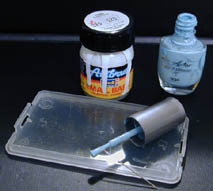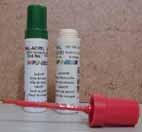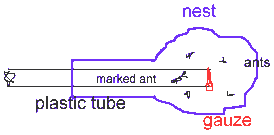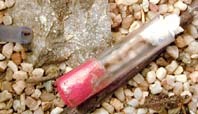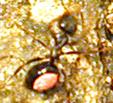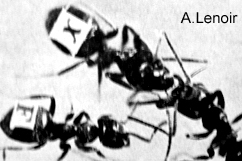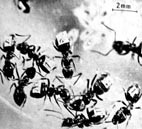zu beachten:
nützliche markierungstechniken.
kriterien um sich für eine geignete markierungstechnik zu entscheiden.
Techniques for Marking Insects
probleme, markierungstechniken:
ich markiere die ameisen mit nagellack oder modellbaufarbe.
ich trage die farbe mit einem zahnstocher oder einer nadel auf.
ich lasse die farbe 5 stunden trocknen
dann lasse ich sie frei. die anderen ameisen beginnen sie heftig zu putzen.
meistens wird die farbe abgewischt oder die ameise getötet. ich habe das mit etwa
10 ameisen versucht, aber nur eine behielt die markierung mehrere monate.
Richard Rowe sagte in einer newsgroup
"Some ants have a low tolerance for marking - e.g. Oecophylla smaragdina
where the animal goes berserk, and after it calms down
mutual grooming
colony members tear off the paint usually dismembering the marked animal
in the process."
die farbe nicht trocknen lassen!es ist besser die ameise zurück zu
tun w&aauml;hrend die farbe noch feucht ist.
at
Florida Entomologist bestätigen dies in einem artikel.
An Improved and Quantified Technique for Marking Individual Fire Ants
hauptproblem:
der kolonieduft ist das hauptproblem.
während der markierung verliert die ameise den typischen kolonieduft.
die anderen ameisen denken: wow die hat einen stinkenden fleck am arsch, der muss weg!
und beginnen wie wild sie zu reinigen.
wenn sie während dieses prozesses den kolonieduft nicht übernimmt
wird sie von der gemeinschaft ausgestossen also
getötet oder sie ist ohnehin vom reinigen so geschädigt, dass sie stirbt.
wenn die farbe noch feucht ist, nimmt sie den duft besser an.
für lasius niger ist das noch keine lösung. auch wenn man sie
langsam einführt. man friert die ameise 3-5 min ein bevor man sie zurück tut.
die einfrierungstechnik wird von Chris128 erklärt (english)
Chilling Ants Experiment(ant farm`s messageboard)
Chris128 benutzt die technik um fremde ameisen derselben
art in einer fremden kolonie einzuführen.
|
things to consider:
the following criteria should be considered when selecting a marking
technique. marking techniques that have proved useful in entomological studies.
Techniques for Marking Insects
problems, marking techniques:
i mark them with fingernail-paint (i tried model paint too).
i apply the paint with a needle or toothpick.
if i mark an ant i keep them out for 5 hours for the color to dry.
after that i put them back to the others.
other ants start cleaning the marked ant 3 at a time very fiercely.many times the
mark is removed. and sometimes i belive the ant is killed.
i have tried this with i belive 10 ants but only one kept the mark a long time (two
month).
Richard Rowe mentioned in a newsgroup:
"Some ants have a low tolerance for marking - e.g. Oecophylla smaragdina
where the animal goes berserk, and after it calms down
mutual grooming
colony members tear off the paint usually dismembering the marked animal
in the process."
do not let the color dry. it is better to put the marked ant back
while the color is still wet.
at
Florida Entomologist in the article
An Improved and Quantified Technique for Marking Individual Fire Ants
a research group says that it is better to put the ants back when the color is still wet.
main problem:
colony odor is the main problem. the marked ant looses
colony odor in the process of marking. the other ants think: wow your ass stinks! and then they
begin grooming. if they are unable to transmit the colony odor in this process they
alienate the marked ant or she is damaged by the fierce grooming. so if the paint
is still wet it can acquire the colony odor quicker. but this is not a
solution if you deal with lasius niger.
even if you introduce her gently by freezing her before putting her back
it is not probable that she will keep the mark.this chilling is described by Chris128 in the posting
Chilling Ants Experiment(ant farm`s messageboard)
|
